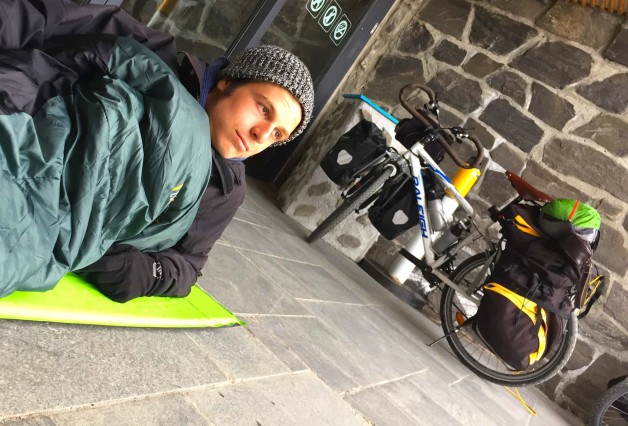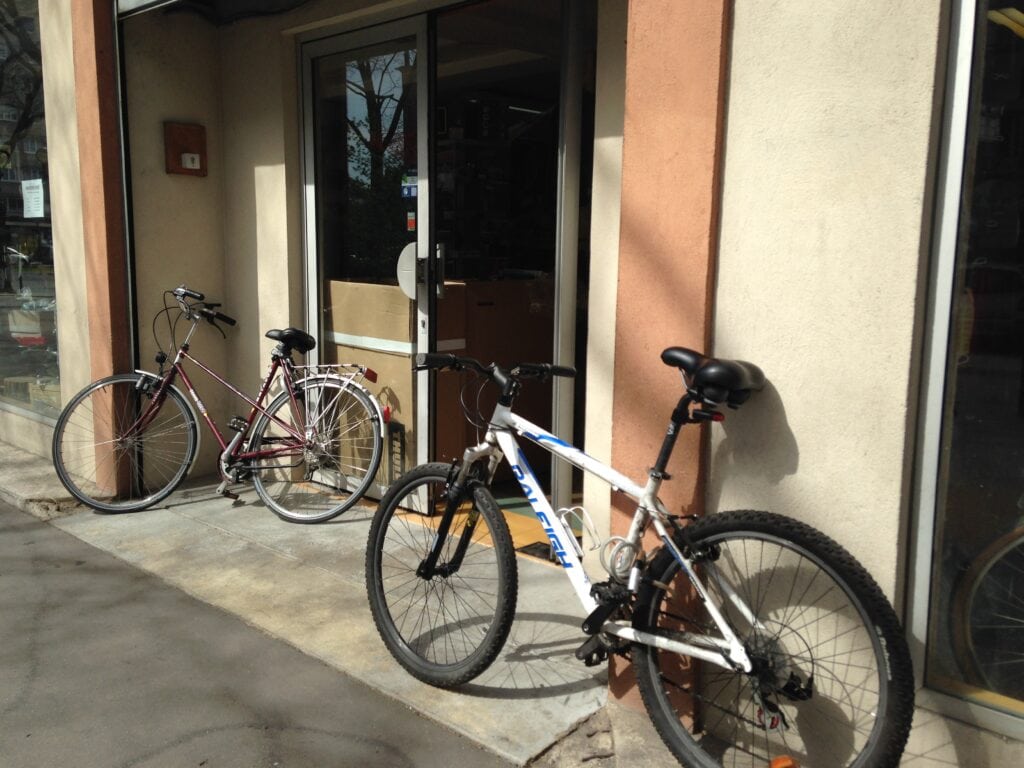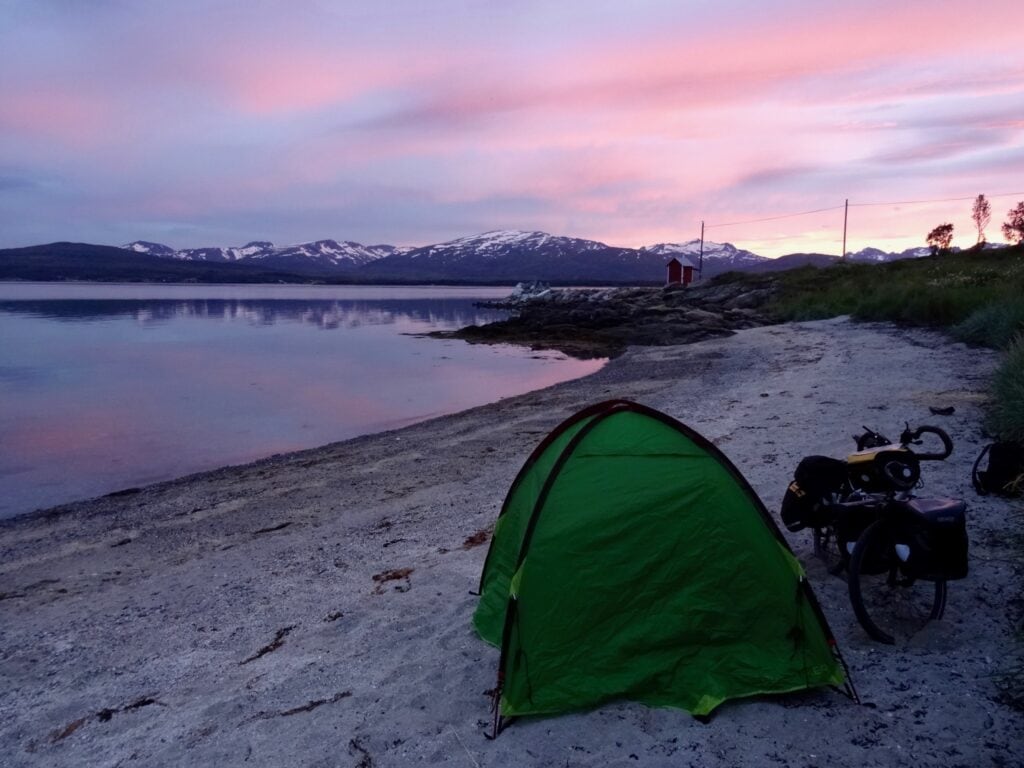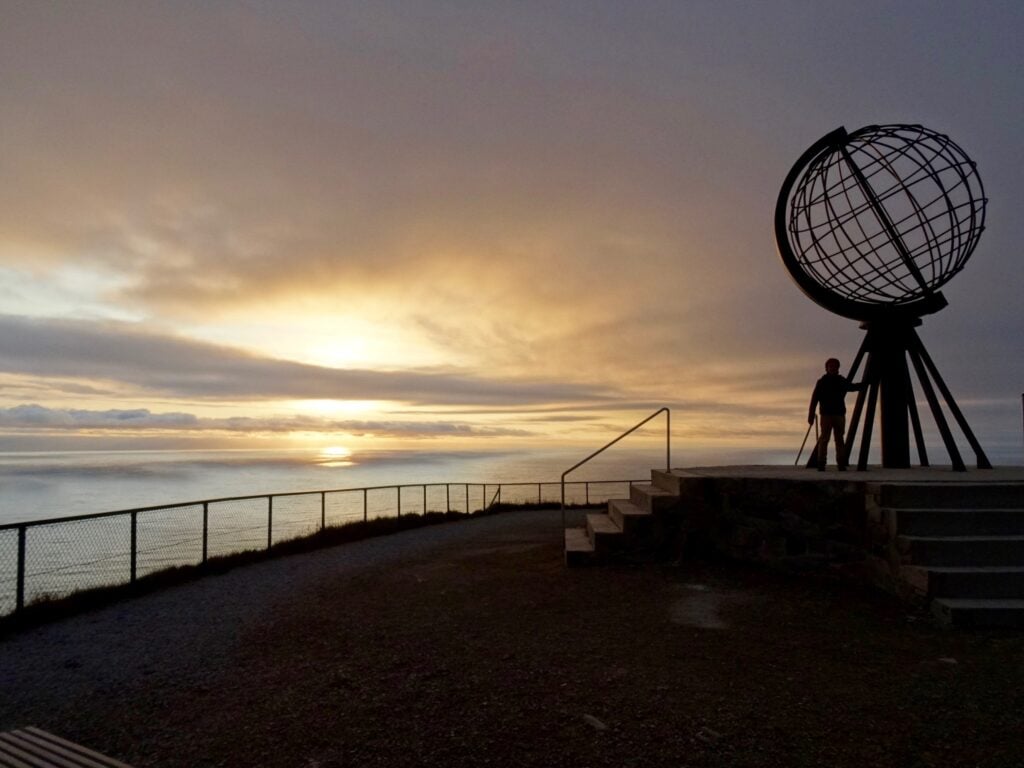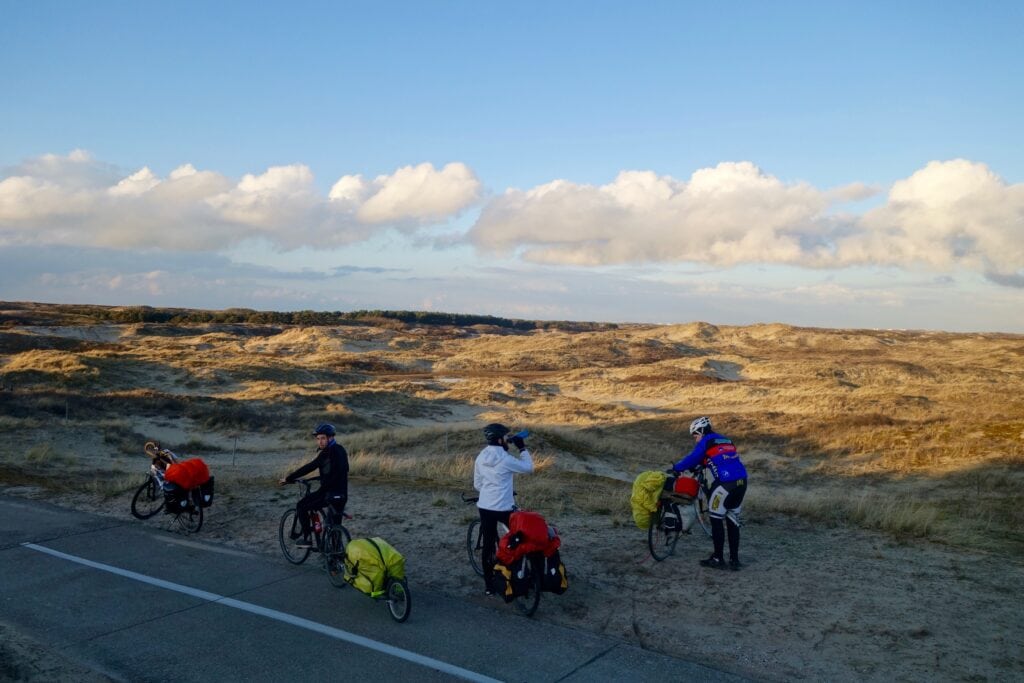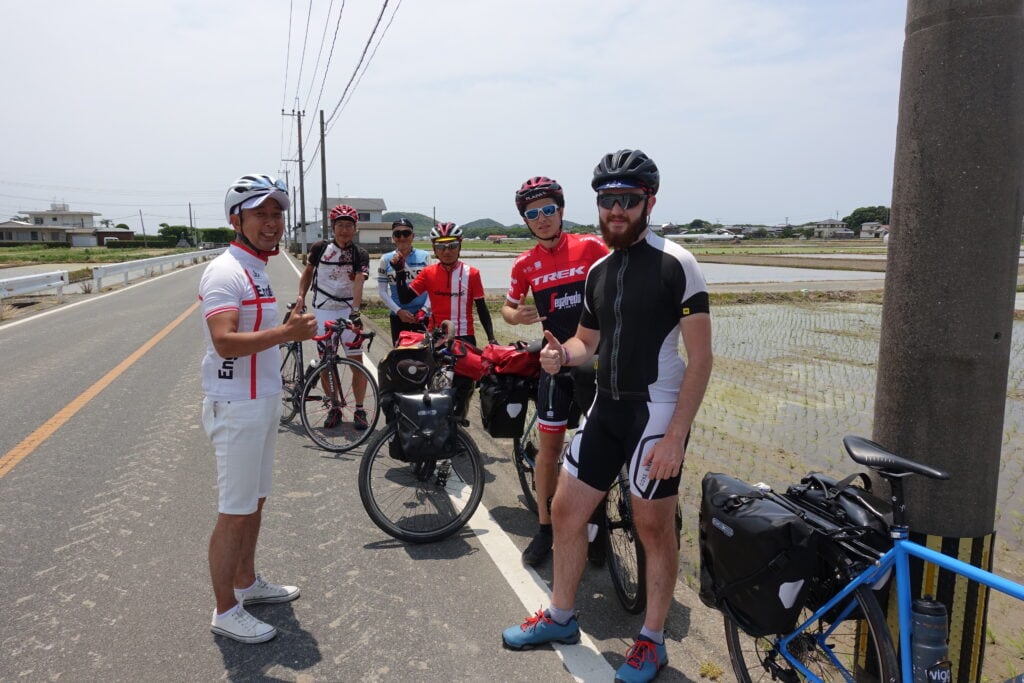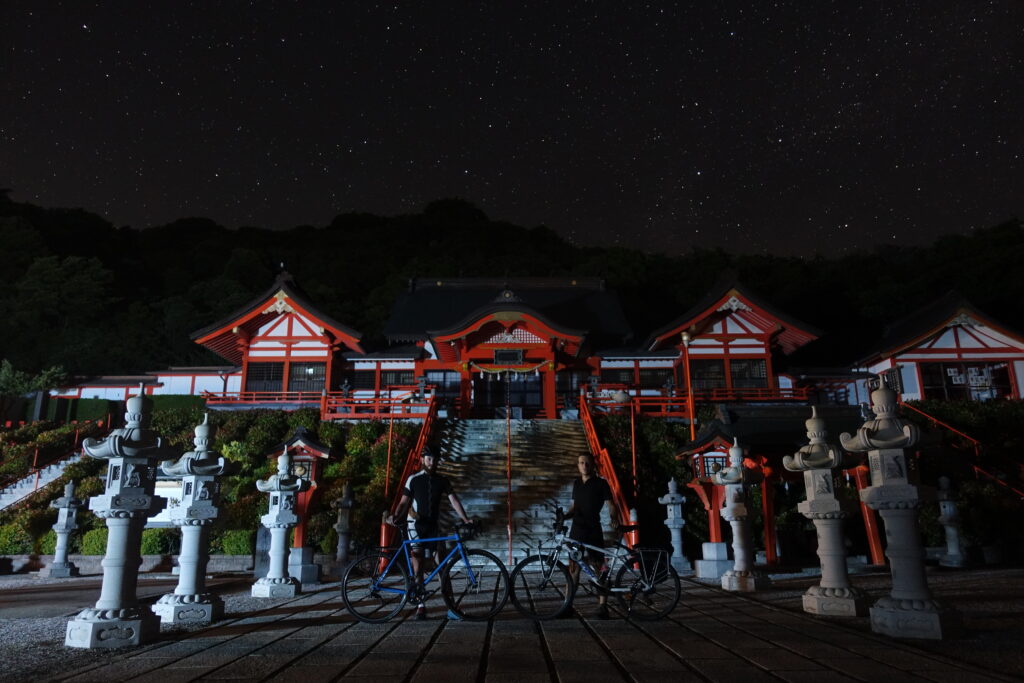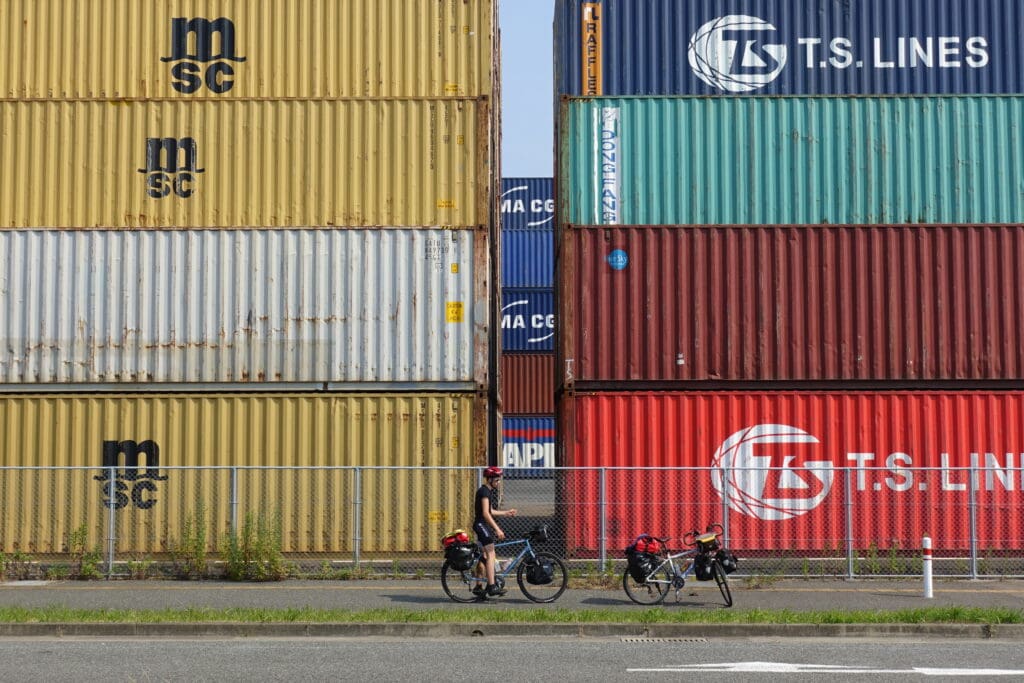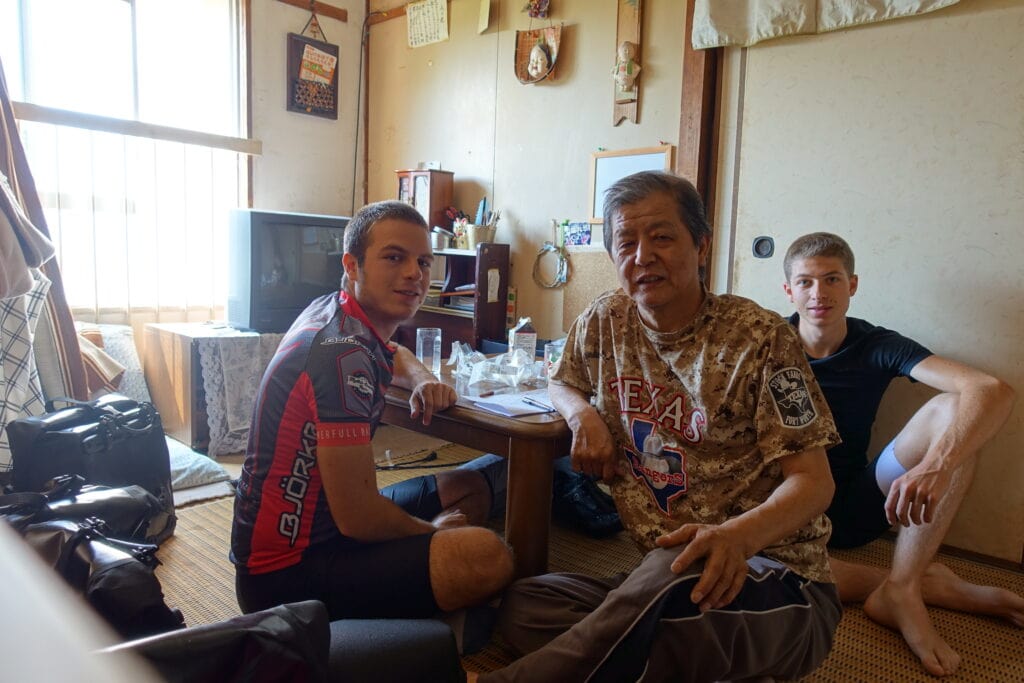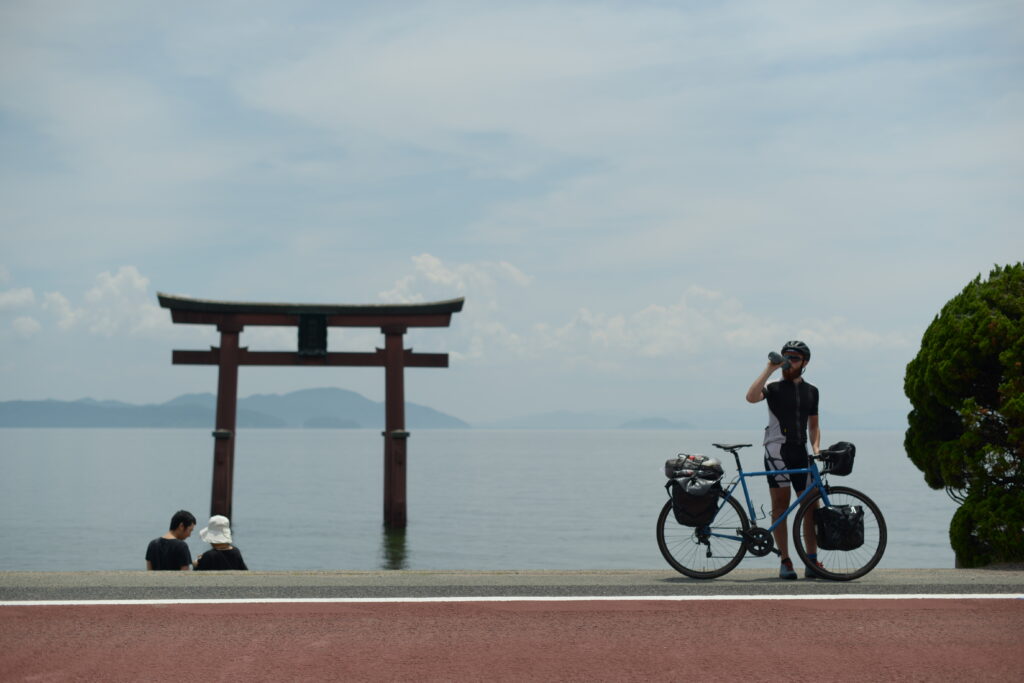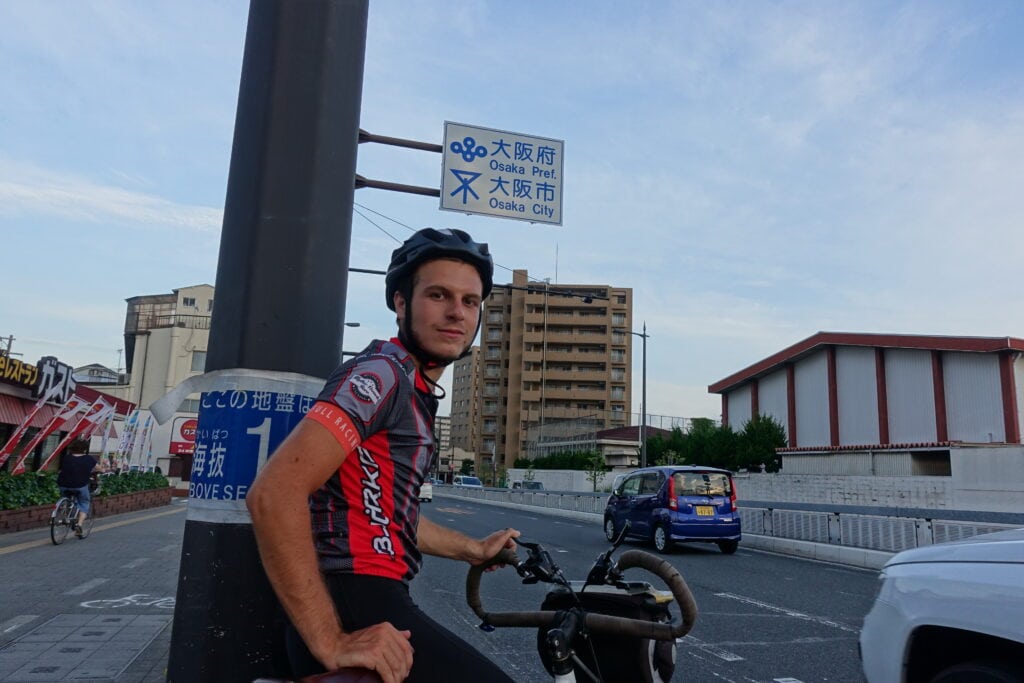J’ai connu Mattéo suite au film qu’il a fait après son voyage en Iran, l’année de ses 17 ans. Depuis nous suivons nos pérégrinations respectives via les réseaux. Il a fait beaucoup de très beaux voyages mais il y en a certains que j’affectionne particulièrement: ceux à vélo.
Un jour de confinement, on échange sur Messenger, comme on le fait épisodiquement pour s’échanger nos anecdotes de voyages. Me vient alors l’idée de lui demander d’écrire un article sur ses voyages à bicyclette. Il est très enthousiaste et quelques jours plus tard me renvoi cet article extrêmement riches en informations.
Sommaire
- 1 En selle ! 2020, une occasion de te lancer dans ton tout premier voyage à vélo.
- 2 Cap sur la Norvège
- 3 Février 2016 : Paris – Amsterdam à vélo
- 3.1 Quels particularités pour cette aventure ?
- 3.2 ’est avec Victor, Hugo et Loïc que nous allons partir pour Amsterdam. Nous sommes au début du mois de février 2016 et la semaine à venir est annoncée comme la plus froide de l’hiver. Le thermomètre frôle les 0°C durant la journée. Ce format particulier permet de souligner quelques points spécifiques sur le voyage à vélo dans des conditions difficiles.
- 3.3 Quelques conseils ?
- 3.4 Quel bilan pour cette aventure ?
- 4 Été 2017 : Welcome to Japan – Tour du Japon à Vélo
En selle ! 2020, une occasion de te lancer dans ton tout premier voyage à vélo.
Parlons d’une façon de voyager, très sympa, qui s’est beaucoup développée ces dernières années : le vélo. Ce mode a rythmé certains étés et hivers de ma période d’étudiant. Le but de cet article est de te montrer que le voyage à vélo est accessible à tous ! Il suffit de se motiver et de bien suivre l’idée que tu as en tête. Prêt à rejoindre le peloton ? Dans cet article, nous allons évoquer pas un ou deux mais trois formats différents ! Allez, en selle.
Pour tout commencer, j’ai dû m’accrocher à cette idée, il y a 5 ans lorsque j’étais en classe de terminale. Mes parents me voyaient retaper un vieux VTT trouvé au fond du garage, parcourir les cartes de l’Europe du Nord, il devaient se dire que quelque chose se tramait ! J’avais un rêve bien enfoui : atteindre le Cap Nord à vélo, tout en haut de la Norvège, le point le plus septentrional de l’Europe, à 2100 kilomètres du Pôle Nord.
Le vélo en question, avant un relifting devant la boutique, une caverne d’alibaba du voyageur à vélo qui a malheureusement fermé ses portes. Autant vous dire que ce modèle de selle n’a pas duré longtemps et a été changé par une Brooks bien plus dure et adaptée aux longues distances. Le choix de la selle reste assez subjectif.
Cap sur la Norvège
Comment est venu l’idée de ce voyage ?
Le Cap Nord est une destination qui m’intrigue depuis longtemps, cependant, je ne savais pas comment m’y rendre. En juin 2013, j’ai l’idée d’y aller en voiture mais cela coûte cher et il faut rouler longtemps avant d’y arriver, et puis sans permis on ne va pas bien loin en voiture. De même pour le train, qui s’arrête 1.500 kilomètres avant la pointe Nord, il faudrait donc finir le trajet en car.
Les mois défilent et je me décide à une « gros truc » à la sortie du lycée. En parallèle, Samy, mon professeur de physique chimie ponctue certains cours de ses exploits à vélo, en Europe ou en Afrique. Et pour le coup, il n’a pas choisi les endroits les plus faciles. Jusqu’à Ouagadougou à vélo ou dans le Sud de l’Espagne :
« C’était génial! L’après-midi on dévalait la montagne, il faisait froid. Puis on arrivait sur la côte en fin de journée, direction la boîte de nuit ». Forcément, ça donne envie. Je viens le voir à la fin de certains cours pour lui poser des questions, non pas sur la physique ou la chimie, mais sur l’organisation d’un voyage à vélo : « – Pour la tente, rien de plus simple, tu peux la caler derrière ta selle ». Je ne sais toujours pas comment une tente peut venir se mettre derrière la selle, alors je l’ai laissée reposer tranquillement sur le porte-bagage.
En janvier 2015, Samy me parle d’un festival dédié au voyage à vélo. Décidément, il existe des festivals pour quasiment tout. Je me rends à Vincennes sur les lieux et découvre une communauté passionnée par ce mode de voyage. Je rencontre un auteur qui expose son voyage en Norvège du Nord. Il me donne un tas de conseils pour cette région. À l’entendre parler, le trajet à l’air plutôt simple, en tous cas il me prouve qu’il est possible d’y aller seul à vélo. En fait, ce festival était peuplé de gens aux histoires formidables. Ils te racontaient dans le plus grand des calmes qu’ils avaient traversé 2 tornades, 3 guerres civiles, 1 tsunami et 1 million de kilomètres à vélo, et que tout allait bien. Forcément, ça rassure.
Quelle a été la préparation nécessaire ?
Le défi semble donc à ma portée et je me lance dans la préparation de mon premier voyage à vélo. Après tout, ce moyen est certes plus lent, mais il permet de s’arrêter n’importe où pour mieux apprécier les paysages. Dans une société où on se presse partout, je pourrai enfin me dire « il faut rouler 4 jours pour atteindre cette ville ». Et si ça me prend 6 jours, ce ne sera pas plus mal!
Je profite des vacances de Pâques pour rassembler le matériel nécessaire et équiper ce bon vieux VTT. Ma mère guette souvent par la fenêtre, et doit se dire que ça sera difficile de faire marche arrière. Je réussis à la convaincre en expliquant que, durant l’été, le soleil ne se couche pas là-bas. Donc tous les risques liés à la nuit n’existent plus vraiment. C’est décidé, le grand départ aura lieu le 9 juillet !
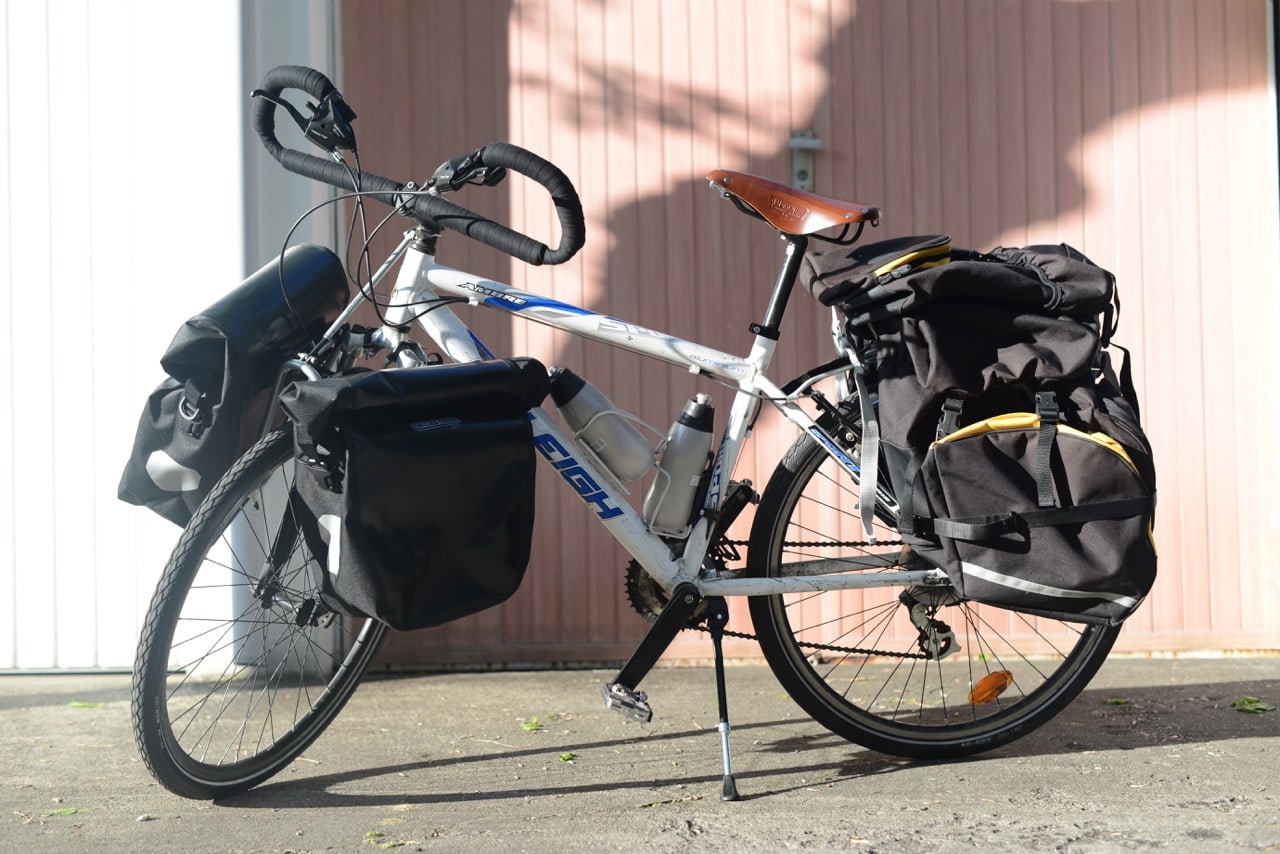
Comment s’est passé ce voyage ?
9 juillet 2015, j’ouvre le hublot de l’avion qui m’envoie à Bodo, le point de départ du projet. Je n’avais jamais vu autant de neige en juillet et je me demande pourquoi j’ai décidé d’aller là-bas au lieu de faire la fête à Barcelone. Surtout, je n’avais quasiment aucun entraînement et je n’avais jamais roulé avec un vélo chargé. En me retournant, aucun pote sur les sièges voisins. C’était aussi mon premier voyage solo.
Je suis parti seul pour apprendre à mieux me connaître et pour dépasser mes limites. Cela m’a permis de découvrir un niveau de liberté jamais vécu auparavant mais aussi d’évoluer en totale autonomie avec les responsabilités que cela implique. Il faut aussi le dire, être seul te rend 100% disponible pour de nouvelles rencontres.
Finalement, je n’étais pas tout le temps seul. J’ai suivi la route cyclable européenne Eurovélo 1 et je croisais des cyclo-voyageurs tous les jours. Parfois nous roulions ensemble puis nous nous séparions à la fin de la journée pour reprendre nos rythmes respectifs. A l’arrivée, j’ai retrouvé une grande partie des personnes rencontrées sur la route. Nous avions parcouru le même chemin mais chacun avait sa propre histoire à partager ! On pouvait aussi comparer les barbes doubler ou tripler de longueur. Sauf pour moi, à 18 ans, il n’y avait pas encore grand chose sur le menton.
Pour le manque d’entraînement, ce n’est pas si grave. Ce voyage n’est pas une course contre la montre donc mon rythme est plutôt léger. En partant le matin, la seule chose à faire est de rouler toute la journée. En plus, le soleil ne se couche pas donc je peux continuer jusqu’à minuit si l’envie me prend.
Quel était la journée type ?
Je me réveille vers 7h du matin pour attaquer la journée. Je prends environ une heure pour déjeuner, replier la tente et me brosser les dents. Je pars ensuite sur la route en direction du Nord, ça tombe bien, il n’y a qu’une seule route ici. En milieu de matinée, je prends une pause pour manger des fruits secs gorgés de sucres rapides, afin de tenir le rythme jusqu’au déjeuner, qui avait lieu sur une table ou un banc d’abri-bus. Il ne faut pas s’éterniser sur le déjeuner afin de ne pas se refroidir complètement.
Vient le meilleur moment, le début de soirée. Je pars à la recherche d’un endroit sympa pour y passer la nuit. Une fois la tente installée, je lance le réchaud sur un fond de radio norvégienne, puis rien d’autre. Pas d’internet inclus dans le forfait en Europe à cette époque, on était bien tranquille (sauf ma mère). Ça m’arrivait de rouler jusqu’à minuit ou même 2h du matin. Les routes étaient complètement vides et le pays était plongé dans le silence en plein jour… Impressionnant !
J’alternais un jour sur deux entre camping sauvage et camping aménagé. Le camping aménagé me permettait de prendre une douche chaude, indispensable, avant de me coucher. Je n’avais pas accès à la douche en camping sauvage donc je me lavais dans les toilettes des cafés routiers plus tôt dans la journée. Avec mes appareils qui chargeaient sur les prises et le pompage de wifi, le resto routier se transformait en vrai squat. J’avais même ramené une multiprise.
Lorsque le climat est devenu difficile, je partageais une chambre d’hôtel avec d’autres cyclos. Je garde un bon souvenir des nuits passées en Norvège, surtout celles chez l’habitant. Je m’endormais bercé par le son des vagues et de la brise la plupart du temps. La plupart du temps, à vélo, les gens te voient comme un « gentil », ce qui maximise les chances de te faire accueillir. Attention, ce n’est pas l’hôtel ! Même si la journée a été fatigante et qu’il faisait 5°C sous la pluie, c’est important de passer du temps avec ton hôte et de partager certaines images ou récits de voyage.
Il a fallu traverser certains fjords en ferry. En Norvège ou partout ailleurs dans le monde, quand tu voyages à vélo, le ferry est ton meilleur ami. Rien à emballer ou à protéger, pas de marche à monter, il suffit simplement de garer ta monture à côté des autres voitures. Quand il y a un bar sur le pont, c’est encore mieux. Le ferry te permet aussi de changer de point de vue et de voir les paysages depuis la mer.
Une anecdote en particulier ?
Il faut quand même le souligner, la plus grande satisfaction d’un voyage à vélo, c’est d’arriver au bout. Petit récit.
« Jeudi 23 juillet 2016, 7 heures, c’est le grand jour.
Yves et moi sommes déterminés à en finir avec cette folle aventure. Nous avons fait la plus grosse étape du voyage hier. La partie la plus intense a été le passage du tunnel du Cap Nord. Ce dernier fait 7 kilomètres de long et descend à 280 mètres sous le niveau de la mer avant de remonter sur l’île. Les turbines d’aération sont aussi bruyantes qu’un avion, le passage des voitures et la rude montée apportent beaucoup de difficultés à la traversée.
Désormais, nous sommes sur l’île du Cap Nord, l’île de la fin du monde. Nous avons dormi dans une auberge à Honningsvag afin de nous reposer correctement la veille de l’arrivée. Le thermomètre oscille entre 5 et 7°C, gants et bonnets sont de rigueur ! Honningsvag est une ville portuaire au sud de l’île. Avec son port, ses logements et ses commerces, elle est le seul lieu de vie sédentaire sur l’île.
Nous sommes à seulement 35 km du Cap Nord. Cependant, la route passe dans les terres et il y a beaucoup de montées et descentes. Nous nous lançons sur la E6, déterminés comme jamais. Au bout d’une dizaine de kilomètres, Yves file droit devant. Il attend ce moment depuis le 1er mai, il doit se donner à fond, c’est sûr. De mon côté j’ai plus de mal dans les montées, le compteur stagne autour de 5km/h, même un piéton avancerait plus vite. Les descentes sont longues mais il faut remonter à chaque fois. C’est interminable. Le paysage est encore plus vierge qu’avant.
J’aperçois quelques bâtiments à l’horizon qui ressemblent à des stations météo. La ligne d’arrivée commence à se faire sentir. Plus que 5 kilomètres seulement. Je ne vois toujours rien devant moi. La dernière montée me défie avec une pente à 9% et il est impossible de voir ce qu’il se cache derrière. Je croise enfin le panneau « NORDKAPP » sur le bas côté, Pause photo obligatoire ! Me voici désormais sur le sprint final. 500 mètres séparent le panneau de l’entrée au complexe touristique. Les voitures font la queue pour passer le péage. 90€ pour une famille avec deux enfants ! Heureusement les vélos peuvent entrer librement, avec un clin d’œil du gardien en guise de reconnaissance. Je contourne le bâtiment et me retrouve au bord de la falaise, face au monument. C’est ici le Cap Nord. Le Pôle Nord n’est qu’à 2100 kilomètres derrière l’horizon. Yves est arrivé il y a une demi-heure, il m’aide à monter le vélo sur le socle du monument pour faire la photo. Le monument, représentant les parallèles du globe terrestre en acier, est situé au bord d’une falaise qui plonge dans la mer, 300 mètres plus bas. L’endroit est saisissant.
Nous passons l’après midi à discuter avec d’autres cyclo-voyageurs. Les profils sont variés, mais quelques points communs ressortent. Mark, 22 ans, étudie les mathématiques à Vienne. Andrea, 26 ans, est ingénieur informaticien à Francfort. Il n’est pas évident d’imaginer ces personnes remettre leur costume pour aller en réunion alors que nous mangeons une soupe aux nouilles devant la tente. En effet, on s’éloigne des personnes en marge de la société auquel cette forme de voyage pourrait faire penser et on se rapproche de jeunes diplômés venant respirer un peu d’air frais.
Les heures passent et je suis heureux de respirer cet air du bout du monde. Le Cap Nord est un endroit fréquenté qui comporte une grande structure où on y trouve un restaurant, une boutique de souvenirs, un cinéma et d’autres commodités pour les visiteurs. Cet aménagement amène un balai de cars incessant. Ce soir, le ciel est dégagé. Une journée comme celle-ci a lieu en moyenne une fois par semaine à cause d’un climat capricieux. Quelle chance de tomber sur ce beau temps ! Nous apercevrons sûrement le soleil de minuit, qui se fait attendre avec impatience. En général, le ciel est entièrement couvert et il est impossible de voir à plus de 20 mètres devant soi. En conséquence, cette soirée est « l’heure de pointe ».
Un navire de croisière allemand a débarqué ses 3 000 passagers au port d’Honningsvag. Un convoi d’une cinquantaine de cars arrive sur place. Le monument est pris d’assaut peu avant minuit. Yves et moi discutons avec un couple de retraités français venus en camping car. Nous sommes gentiment conviés à boire une coupe de champagne dans le véhicule de Jacques et Francine. Nous échangeons durant plusieurs heures, jusqu’à ce que Francine décide d’aller se coucher. Il est 2 heures et demi du matin, nous fermons la porte derrière nous.
Plus aucun bruit. La plateforme du monument est vide, le complexe est fermé. Tous les cars sont repartis au sud. Yves et moi avançons jusqu’au bord de l’océan.
On entend les vagues se rompre 300 mètres plus bas contre la falaise dorée par le soleil qui brille. Je me rends compte de la hauteur à laquelle je me trouve lorsque j’aperçois les oiseaux voler au dessus de l’eau ; ce sont de minuscules points blancs ! Un jeune dessinateur allongé sur son duvet immortalise la scène au fusain. Yves et moi nous installons au pied du monument et faisons chauffer du thé. L’environnement est calme, serein, tout semble s’apaiser. Le Cap Nord nous révèle sa magie au beau milieu de la nuit ensoleillée. La sensation d’être au bout du monde se ressent enfin pleinement. »
Le monument qui symbolise le Cap Nord, à 2 heures du matin.
Cette soirée met fin à la première partie de mon voyage qui est de loin la plus significative. Un flot de bons souvenirs me traverse l’esprit. Je réalise que mon projet a dépassé mes attentes en tout point. Et l’envie de repartir se fait déjà ressentir.
Février 2016 : Paris – Amsterdam à vélo
Quels particularités pour cette aventure ?
C
’est avec Victor, Hugo et Loïc que nous allons partir pour Amsterdam. Nous sommes au début du mois de février 2016 et la semaine à venir est annoncée comme la plus froide de l’hiver. Le thermomètre frôle les 0°C durant la journée. Ce format particulier permet de souligner quelques points spécifiques sur le voyage à vélo dans des conditions difficiles.
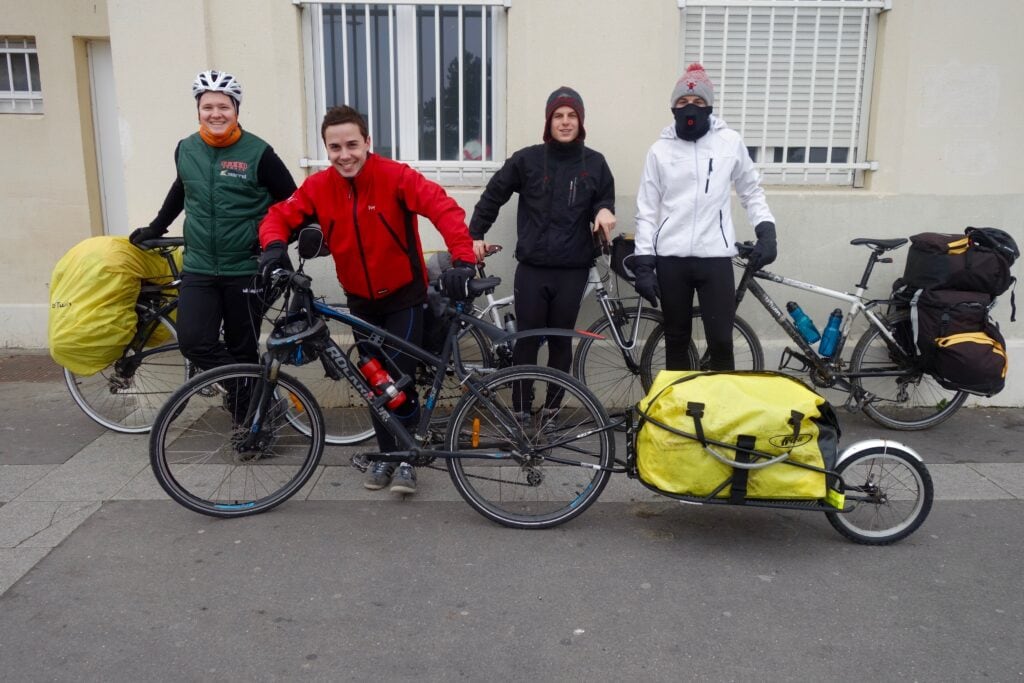
Une priorité : se préparer face au froid. Rouler entre -5°C et 5°C n’est pas une fin en soi, certains équipements permettent de se prémunir du froid et le corps se chauffe tranquillement sur les premières centaines de mètres. Il est important de bien couvrir chaque surface avec un collant de cycliste long, de bonnes chaussettes et une veste polaire. Attention à ne pas ajouter trop de couches pour ne pas être en sueur au bout de plusieurs kilomètres. Il faut jouer avec le froid, se couvrir et se découvrir en fonction de son ressenti de température, avec pour objectif de ne pas trop transpirer afin de ne pas attraper froid.
Quelques conseils ?
Nous sommes partis du nord de Paris, direction Lille puis Bruges et enfin Amsterdam. Entre Paris et Lille, Victor, un membre de l’équipe, connaît très bien les routes locales. On a pu éviter les nationales et départementales prises par le trafic dans une région où les camions sont fréquents.
Sois vigilant sur ce point car les axes France-Belgique-Pays Bas sont très fréquentés et tu peux vite te retrouver sur une voie rapide pleine de semi-remorques. À partir de la Belgique, les pistes cyclables font peu à peu leur apparition jusqu’à être omniprésentes aux Pays-Bas. Là-bas, il y en a partout, le réseau est structuré au niveau national. Il est fréquent de longer une nationale ou une autoroute sur la piste cyclable qui la suit. Attention à ne pas rouler sur la route, les véhicules réagissent vite car les vélos n’ont plus trop de raison de partager la route avec les voiture dans ce pays. Le vent peut aussi poser problème. Très fréquent sur la côte hollandaise, un de nous se mettait face au vent pour protéger les autres à tour de rôle. Parfois, on avance plus vite à plusieurs !
Pour les nuits en bivouac, nous avons échoué à 200%. Ne crois pas que les campings t’accueilleront un bon mois de février, ils sont presque tous fermés ! La présence de caravanes peut porter à confusion mais bien souvent, elles sont là toute l’année et vides en hiver. La totalité des campings ne pouvaient nous recevoir, on a malgré tout réussi à squatter une place cachés derrière un mobile home aux Pays-Bas, mais il a vite fallu bouger le matin… Ce trajet entre Paris et Amsterdam a été particulièrement intense car nous avons fait face au froid, à la pluie et au vent. Dans ces conditions, il est capital de pouvoir trouver un endroit pour mettre ses affaires au chaud le soir et repartir au sec le lendemain. Pour les nuits chez l’habitant, un des avantages de voyager en groupe est que certains peuvent animer la soirée pendant que d’autres se reposent.
Autre détail pratique : nous avons dû switcher entre différentes affaires selon la météo et gérer si ces affaires étaient étaient sèches ou non. Le plus pratique pour ce genre de voyage est de se munir de « pochettes séparatrices ». Elles permettent de différencier les affaires et de compacter chaque bloc. On gagne en temps et en volume, ce qui est non négligeable en hiver. J’ai gardé le système des pochettes séparatrices pour tous mes voyages qui ont suivi.
Quel bilan pour cette aventure ?
Malgré la météo hivernale, plusieurs points ont permis de nous réconforter durant ce voyage, à savoir :
⁃ L’accueil et la gentillesse des personnes que nous avons rencontrées tout au long du séjour. La journée passée à l’extérieur rendait les moments au chaud encore plus chaleureux. On avait l’impression de revenir d’un champ de bataille lorsqu’on échangeait le soir avec nos hôtes.
⁃ La nourriture du Nord nous a bien aidé, à savoir les frites ! Ça réchauffe, ça cale et ça tient au corps, que demander de plus.
⁃ La côte préservée après le passage de la frontière hollandaise, bordée de plages et de dunes très sympas. On oublie que des métropoles se situent à quelques kilomètres comme La Hague ou Amsterdam et son aéroport. La traversée du port de Rotterdam nous sort de ce cadre naturel, mais ça ne dure pas longtemps et les aménagements te font vite oublier que tu passes par le plus grand port européen.
Ce trajet fut bref, seulement 6 jours. Mais son intensité nous a laissé des souvenirs impérissables. Je recommande cet itinéraire simple à mettre en place si tu disposes d’une semaine et que tu te demandes quand quelle direction partir.
Les nombreuses pistes cyclables en Belgique et surtout aux Pays-Bas permettent de ne plus penser aux voitures qui te dépassent. Le retour se fait simplement en train, bien vérifier cependant si les vélos sont acceptés à bord, apparemment les règles changent pour ajouter davantage de sièges…
Été 2017 : Welcome to Japan – Tour du Japon à Vélo
Quel était l’idée de ce voyage ?
Ce voyage s’est déroulé en équipe de 3, avec pour objectif de rejoindre Tokyo depuis Fukuoka. Le Japon est un pays comportant des zones urbaines très denses. Le but de traverser ce pays à vélo est de voir ce qu’il y a entre deux centres urbains : la côte, la campagne ou la montagne. Ce mode de voyage y a pris tout son intérêt car on a pu prendre le temps de voir ce qu’il y a entre chaque ville au lieu de se « téléporter » d’une ville à l’autre.
Loïc (devant) et Thomas en train de suivre une équipe de cyclistes locaux.
Rouler au Japon confère plusieurs avantages :
⁃ Les routes sont en bon état et les conducteurs respectueux. Certains d’entre eux n’hésitent pas à rouler en contre-sens pour nous doubler avec une distance suffisante.
⁃ Le pays est sûr, il est donc possible poser sa tente dans un parc public et de laisser une partie de ses affaires à l’extérieur sans craindre de ne les revoir. Durant les visites de temples ou les repas au restaurant, il suffit d’attacher son vélo sur les emplacements prévus à cet effet et il ne bougera pas, même avec les bagages dessus. Pense à la sacoche guidon détachable pour en faire ton « sac à main » et garde tes effets personnels sur toi !
⁃ La densité des villes et la variété des paysages permet de ne pas s’ennuyer. On part le matin d’un village de pêcheurs, on traverse quelques montagnes l’après-midi et on arrive dans une grande ville le soir. Ce point est important car il peut arriver de se lasser de longues lignes droites et monotones et de décider de changer ses plans.
⁃ Il est possible de se nourrir sans dépenser une fortune. Cela évite de transporter des denrées avec soi et de cuisiner en mode camping. C’est aussi une invitation à goûter les nombreuses spécialités propres à chaque région japonaise. Les supermarchés regorgent de plats simples déjà préparés et à petit budget, attention cependant aux emballages plastique qui abondent dans ce type de produits.
⁃ S’il te manque du matériel ou qu’une pièce casse, il sera possible de trouver quasiment tout ce dont tu as besoin pour remettre ta monture sur les rails. En cas de problème technique majeur ou de blessure, le pays est très bien maillé en transport ferroviaire et routier, ce qui te permettra d’atteindre tes prochaines étapes sans souci. Attention aux trains qui demandent à emballer le vélo dans une housse d’une certaine dimension. Il est possible de trouver cette housse dans tout magasin de vélo local.
⁃ Tu vas attirer la curiosité des passants, en particulier lorsque t’arrêtes devant une supérette pour y prendre une pause. Un bon moyen de démarrer la conversation avec les locaux qui ne seraient pas forcément avenants avec les étrangers.
Comment se composait l’équipe ?
Notre équipe compte Thomas, qui découvre par la même occasion le voyage à vélo.
Thomas a montré qu’il est possible de se joindre à d’autres habitués de ce mode de voyage, sans préparation physique et en partant de quasiment 0 avec le matériel. Avant de partir, il sentait qu’il avait besoin de s’entraîner pour pouvoir suivre la cadence. Finalement il n’a pas eu le temps de beaucoup s’entraîner et ça n’a pas posé tant de problèmes. Seul Loïc pratiquait régulièrement le vélo les mois précédant le voyage. Donc si un groupe d’amis te propose de les rejoindre dans leur prochain voyage à vélo, n’hésite pas et fonce.
On retrouve la même excitation de se lancer dans une page blanche, en sachant où on atterri et où on décolle mais sans avoir prévu ce qui se passera entre les deux. Un détail à noter par rapport aux précédents voyages : la météo. Les étés japonais sont chauds et humides, et on s’en rend très vite compte en dormant dans la tente !
Pour l’anecdote, nous avions découvert la seconde aération, permettent de faire passer un flux d’air la nuit pour rafraîchir la tente, le dernier jour en remballant tout le matériel…Il ne faut pas s’étonner si les températures ne baissent pas durant la nuit en été.
Autre point : attends-toi à te lever tôt. Le fuseau horaire fait en sorte que le soleil se lève sous les coups de 4h30 – 5h en juin, à 6h30 ça commence déjà à taper et on est obligés de se lever.
Comment s’est organisé le voyage ?
Nous avons partagé le voyage en deux modes de vie bien distincts : le mode « citadin », où on posait les bagages à l’auberge durant quelques jours, on se déplaçait avec les vélos à vide pour visiter la ville et on profitait des restaurants le soir et de la vie nocturne.
Le mode « nomade », quant à lui, était réservé aux régions moins urbaines, où les vélos restaient tout le temps chargés et qu’on dormait soit en tente, soit chez l’habitant. Dans cette configuration, le rythme de sommeil corrèle avec le soleil. On se couche tôt et on se lève très tôt.
Ce mode influe aussi sur le rythme de dépenses. De 5 à 10€ par jour par personne en mode nomade, nous pouvions dépenser jusqu’à 30€ par jour en vivant en ville. Forcément en ville on roule moins, donc on a plus de temps disponible pour consommer. Les auberges hôtels étaient réservés la veille pour le lendemain sur des plateformes en ligne type Booking ou le jour même si on ne trouvait vraiment rien pour dormir.
Il est intéressant de diviser mentalement le pays en plusieurs itinéraires possibles. Longer la côte t’évitera de grimper puis descendre la plupart des montagnes au centre du territoire.
⁃ La côte « Nord », bordant la Mer du Japon, est moins industrialisée et moins bétonnée de façon générale. Attends-toi à enchaîner des villages de pêcheurs tous mignons.
⁃ La côte « Sud », bordant l’océan Pacifique, est incontournable pour passer à travers les villes de Hiroshima, Osaka, Fujinomiya ou Tokyo, mais c’est aussi la région la plus industrialisée. À l’exception de l’île de Shikoku, attends-toi à t’engouffrer dans des ports gargantuesques et à croiser beaucoup de camions de marchandises.
– Enfin, passer « au milieu », c’est à dire à travers les Alpes Japonaises, te plongera dans un cadre vert permanent et t’épargnera de la pollution. Mais gare aux montées ! Nous avons opté pour la solution « zig-zag » en tirant le meilleur des 3 ambiances.
Cette logique géographique peut s’appliquer à pas mal de pays, il suffit de regarder la concentration des villes sur une carte. Certaines côtes sont très actives et représentent le poumon économique d’un pays. Certes, tu peux y trouver des villes sympathiques mais tu passeras à travers beaucoup de zones industrielles. Et à part être fan de conteneurs, traverser ces étendues d’acier et de béton à vélo n’est pas forcément agréable.
En se rapprochant des tropiques, la meilleure saison pour partir est clairement le printemps ou l’automne. Les étés chauds et humides auront raison de tes exploits sportifs. Nous avons passé de nombreuses journées à engloutir des litres de boissons afin de compenser les pertes liées à la chaleur.
Thomas a opté pour un sac à viande doux au lieu d’un sac de couchage, donnant l’impression d’avoir une couverture tout en restant au frais.
Autre détail pratique lié à la température : les chaussures. Puisqu’il fait quasiment tout le temps chaud, je te conseille de porter des sandales ou chaussures ouvertes. Désormais, certaines sont même compatibles avec les pédales auto. Les sandales sèchent vite après une grosse averse et laissent votre pied respirer à l’air libre. Cependant, gare à ton bronzage au niveau des pieds, il prendra des formes comme tu n’en n’as jamais vues auparavant !
Quelques chiffres ?
Concernant les statistiques, nous avons tout explosé par rapport à nos précédents voyages.
40 jours sur la route, sans compter les 2, 3 jours pour visiter chaque ville, 2 598 kilomètres parcourus en 112,5h ce qui porte la moyenne générale à 64 kilomètres par jour à 23 km/h.
Cependant, attention à ne pas trop se focaliser sur la moyenne kilométrique. Même si elle donne un indicateur de ce qui vous attend pour la journée, vous n’êtres pas à l’abri de vous arrêter 30 kilomètres plus loin si le coin vous plaît bien. À l’inverse, avec un bon vent de dos et un objectif ambitieux pour le soir, on peut dépasser les 150 km effectués dans la journée. On sent que le pays reste montagneux avec 19 063 mètres de dénivelé positif cumulé. Attention aux cuisses ! Traverser la montagne demande un coup de boost au moral car la vitesse passe souvent en-dessous de 10 km/h.
Quand on part plus d’un mois à l’autre bout du monde pour rouler tous les jours à vélo, il est bon de se lancer des défis encore plus fou.
Pour Loïc et moi, c’était évidemment l’ascension du Mont Fuji. Un bus emmène les randonneurs à 2300 mètres pour les faire démarrer de la 5 ème station. Nous avons décidé de remplacer l’étape du bus par le vélo, en partant tôt le matin pour arriver à cette station. Partir du bord de la mer et arriver au-dessus des nuages avec son vélo procure déjà une sensation de folie.
Une fois les vélos attachés, nous avons continué à pieds jusqu’à 3 776 mètres d’altitude, sans équipement particulier. Défi relevé ! Une journée intense qui permet de marquer un moment particulier du voyage. Plus de 14 heures d’effort en continu, autant vous dire que nous avons dormi comme des bébés après la descente vertigineuse.
Comment acheminer son vélo à l’autre bout du monde ?
Emballez c’est pesé!
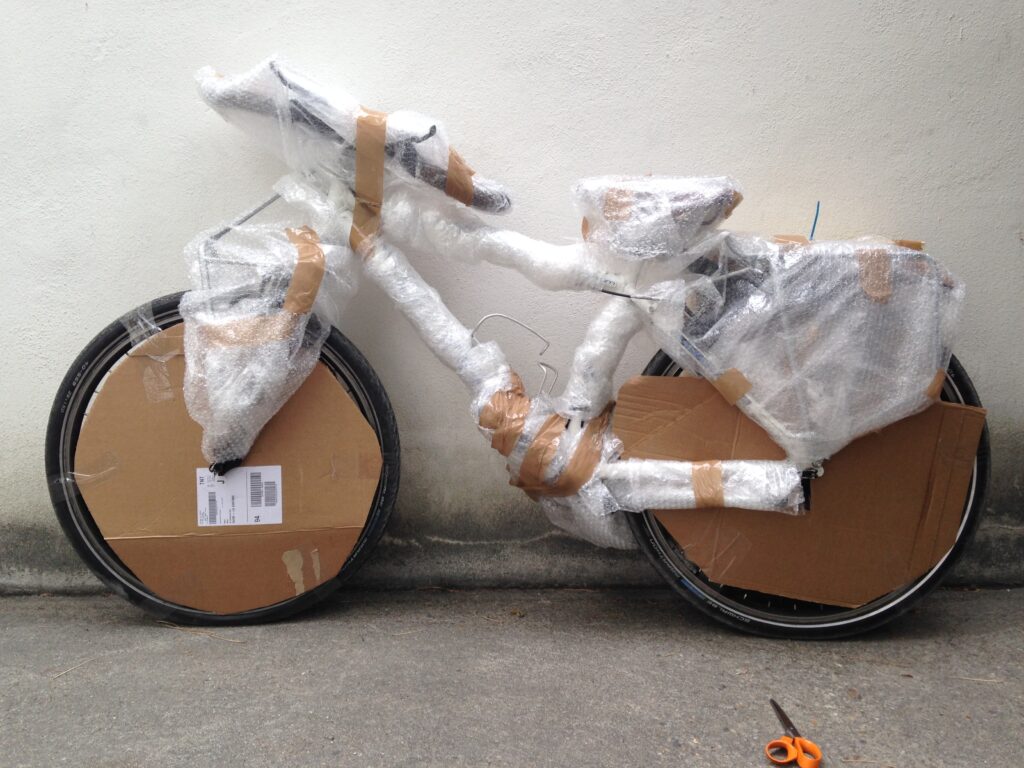
Nous avons réservé des billets en promotion avec la compagnie Cathay Pacific, qui propose une escale à Hong Kong. Je t’invite à lire les conditions sur le site du transporteur pour acheminer des bagages sportifs volumineux. Dans le cas de cette compagnie, il suffisait d’appeler quelques jours avant le départ pour indiquer les dimensions du carton dans lequel le vélo allait être entreposé. Il est possible de récupérer de tels cartons dans des magasins de vélo, lorsqu’ils s’en séparent. Ensuite, il suffisait de glisser nos affaires dans le paquet et nous pouvions embarquer avec notre valise d’un nouveau genre.
Attention à rester vigilant sur certains points :
⁃ Dans les vols avec escale, certaines configurations n’assurent pas la correspondance des bagages jusqu’à la destination finale, surtout si tu enchaînes un vol international suivi d’un vol intérieur. Il sera nécessaire de dédouaner ton paquet à l’aéroport de transfert comme tout passager puis d’enregistrer l’ensemble pour le vol suivant.
⁃ Certaines compagnies imposent des frais supplémentaires, il ne faut pas hésiter à les contacter pour demander si l’équipement de sport peut remplacer ton bagage en soute en bonne et due forme. Il faut suivre les indications données par la compagnie : type d’emballage préconisé, pièces à démonter… etc.
⁃ Repère bien l’aéroport d’arrivée et l’endroit où tu as prévu de passer ta première nuit, surtout si tu arrives en fin de journée! Certains aéroports sont si excentrés qu’il est nécessaire de rouler une demi-journée avant d’attendre le centre-ville. Sache que ton carton a peu de chances d’entrer dans un taxi conventionnel et je te déconseille de te promener avec dans les transports en commun aux heures de pointe…
⁃ Attention à la date et à l’heure du retour. Il nous a fallu un dimanche après-midi entier pour transporter nos cartons du centre-ville de Tokyo à l’aéroport de Narita… en transports en commun. Heureusement, le départ était prévu lundi matin et il était plus sage de passer la nuit à l’aéroport que de se risquer dans un tsunami de voyageurs le lundi. Le dimanche est un bon jour pour se déplacer avec des affaires volumineuses dans les grandes villes asiatiques.
Comment dormir chez l’habitant au Japon ?
Ce n’est pas impossible mais il faut bien s’y prendre. À vrai dire, je ne saurais comment faire dans une grande ville comme Tokyo. De plus, la plupart des logements sont trop petits pour nous faire entrer tous les trois chargés comme des mules. La réalité est différentes dans les zones moins denses ou à la campagne. Il nous arrivait de lier un premier contact devant une supérette sur le bord de la route et de discuter pour éventuellement dormir dans le jardin de la personne le soir même, si ce dernier se trouvait sur notre itinéraire.
Dormir dans le jardin peut au moins nous faire bénéficier de la douche et d’une soirée autour du partage de notre expérience. Parfois, dormir chez l’habitant se révélait être un défi plus extrême.
Selon Loïc : « Pour te donner une idée, nous nous apprêtions à dormir sous un abri devant un supermarché vers Muroto sur l’île de Shikoku et alors que nous sortions nos sacs de couchage, une femme que j’observe de l’autre côté de la route sort de chez elle, s’approche de nous et nous demande en toute simplicité si nous acceptons de dormir chez elle. C’était une magnifique rencontre avec elle et sa famille. Ils tiennent une usine familiale de gâteaux de poisson, nous avons eu le droit d’y goûter au petit-déjeuner, c’était génial. » Je ne te raconte pas l’ambiance au réveil, les odeurs et les bruits de machines toutes activées de bon matin !
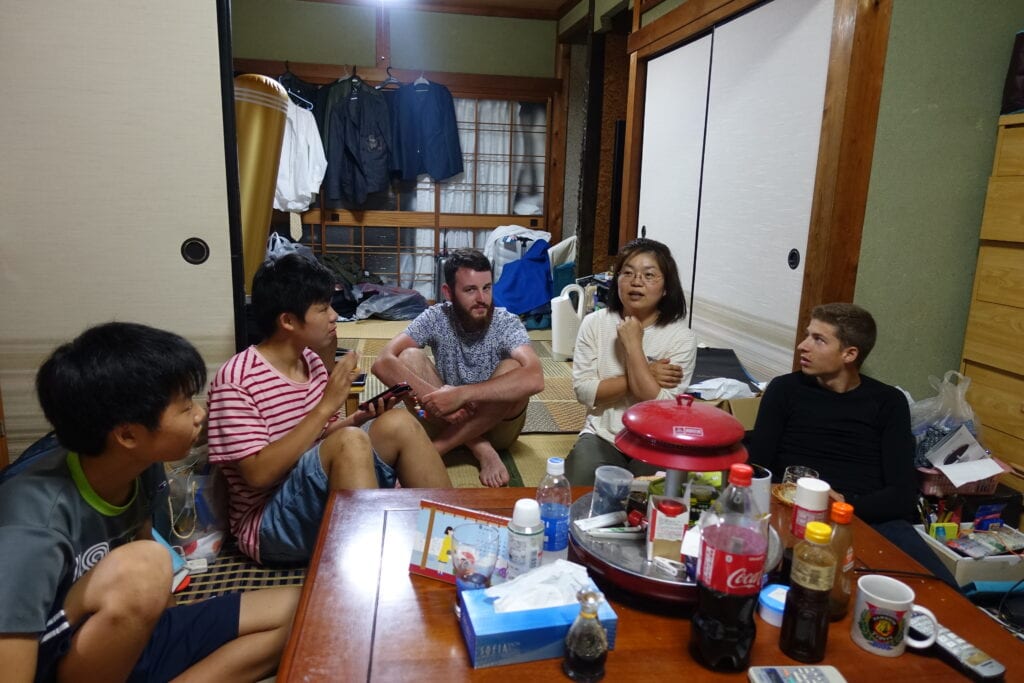
Au début, ces expériences étaient inattendues. Les Japonais nous ont dit qu’il n’était pas courant d’accueillir un japonais inconnu à dormir chez soi. Peut être que ces derniers osent moins demander que les étrangers. En tout cas nous avons été surpris plus d’une fois par le nombre de choses à boire et à manger qu’on nous a gracieusement offert, les invitations à dormir même lorsqu’il s’agissait d’une auberge habituellement payante et la curiosité des gens en dehors des grandes villes. Il étaient surpris quand ils apprenaient qu’on pédalait jusqu’à Tokyo. La première question qui venait était « comment trouvez-vous le temps de faire cela ?»…
Pour conclure, ces voyages sont les rares fois où je me rapproche autant du bonheur. Rouler depuis plusieurs heures avec un son sympa, s’arrêtez et contempler le paysage juste parce qu’on décide de profiter de la vue et se mettre à chanter au milieu de la route en avançant, sont autant de plaisirs simples qui rendent heureux.
Chaque matin je me levais avec l’impression de relever mon plus gros défi jusqu’à présent. La famille et les amis m’encourageaient beaucoup. Je n’avais jamais vu des paysages aussi beaux sur une telle durée. Cette approche du bonheur est en grande partie due aux rencontres avec l’autre, un carburant pour avancer en somme. Chaque échange donnait le sentiment de s’enrichir à bien des égards. Je me sentais en phase avec mon corps durant ces jours de vélo. La forme physique et mentale se faisait sentir et tirait le moral vers le haut. Par ailleurs, voir le point bleu avancer à l’échelle d’un pays sur la carte de mon téléphone donnait beaucoup de satisfaction.
Désormais, je ne peux que recommander de dépasser ses limites constamment, de se jeter dans l’inconnu, de prendre les risques les plus fous tout en étant responsable bien sûr. Il suffit de détermination, de persévérance et de bon sens pour que cela fonctionne. À plusieurs reprises je me suis demandé où m’emmenait ce vélo. Le sourire qui vient aux lèvres quand je me remémore ces images sur le vélo en sont la plus belle récompense.
Merci Mattéo pour ce récit passionné et passionnant. A bientôt pour de nouvelles aventures.


